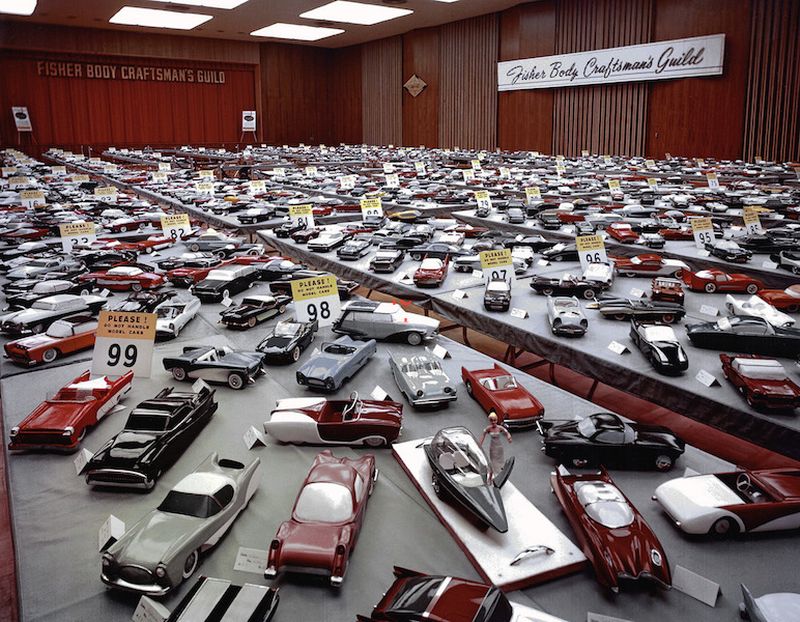 600,000 Youths Work on Autos of Tomorrow, read the headline of a New York Times article of April 2, 1967. Since the end of WWII General Motors had been sponsoring the Fisher Body Craftsman’s Guild, a scaled model automobile design competition. It was a national program promoted through industrial arts programs of our nation’s schools. It offered state and regional cash awards as well as national scholarships valued up to $5000 annually in junior and senior divisions. During these golden years of automobile design, tens of thousands of boys aged 10 to 20 modeled “dream car” and submitted them to the General Motors headquarters for judging. Many of these boys became automobile designers. Prior to the WWII it had been a craftsmanship competition for building model Napoleonic coaches.
600,000 Youths Work on Autos of Tomorrow, read the headline of a New York Times article of April 2, 1967. Since the end of WWII General Motors had been sponsoring the Fisher Body Craftsman’s Guild, a scaled model automobile design competition. It was a national program promoted through industrial arts programs of our nation’s schools. It offered state and regional cash awards as well as national scholarships valued up to $5000 annually in junior and senior divisions. During these golden years of automobile design, tens of thousands of boys aged 10 to 20 modeled “dream car” and submitted them to the General Motors headquarters for judging. Many of these boys became automobile designers. Prior to the WWII it had been a craftsmanship competition for building model Napoleonic coaches.
This website is dedicated the legacy of the talented boys who participated in the Fisher Body Craftsman’s Guild.
Initially the Fisher Body Craftsman’s Guild (FBCG) was a philanthropic foundation “to teach boys craftsmanship.” The Guild was sponsored by Detroit’s famous Fisher Family in May, 1930. The youth program was eventually taken over and run by the General Motors Corporation. Generous university trust funds up to $5,000 were offered as top prizes.
The FBCG morphed into a youth outreach program sponsored by the Fisher Body Division of General Motors to teach boys and young men, ages 11-20 (unskilled amateurs) the principles of “design” and “craftsmanship.” The program lasted from 1930 to1968 and was consistent with Manual Arts and Industrial Arts training taught in our public schools.
The youth of the “Greatest Generation” hand-crafted 1/18 scale miniature model Napoleonic Coaches in what was a technical model-making competition that tested contestants’ abilities for reading blue prints and specifications. After WWII, the “Baby Boomer” generation designed scratch-built “1/12 scaled-model dream cars” from their own imaginations. Harley J. Earl (VP GM Styling 1940-1958) inspired contestants with his experimental show cars and Motorama exhibitions projecting visions of the future. Since the entrants were amateurs, these skills and abilities were honed via “stick-to-it-tivity,” hard work and repeat entries (today called continuous improvement), each successive model entry improving on the previous one, up the ladder of success.
In the grand scheme of things, the “Fisher Body Design Contest” (as it was commonly called) was a highly successful, General Motors talent search, recruiting tool and public relations program. In the 1950s/60s the Guild was used primarily by GM Styling Staff (later named GM Design Staff) to “search for and identify” youth with the “right stuff” (e.g., an eye for beauty, aesthetic sensibility and good taste) – qualities necessary to design and style automobile exteriors and interiors. GM university trust funds nurtured these newly discovered skills and abilities with professional training and education (e.g. Art Center College of Design, Syracuse University, Pratt Institute, Illinois Institute of Technology, and Rhode Island School or Design).
The General Motors’ Fisher Body Craftsman’s Guild was part of the burgeoning field of Industrial Design which came of age during the 40s, 50s and 60s. The prevailing design rule of Modernist industrial designers was “form follows function.” The design ethos of Harley J. Earl was “form follows emotion.” During Earl’s “golden years” of automobile design people fell in love with their cars; they continue to covet model of that era as timeless classics. A common remark about Guildsmen’s models is that they look fresh, modern, and contemporary. This is because good design is timeless and the winning Guild model designs were scrutinized, studied and rated from the working level to the highest executive levels. Harley J. Earl, William Mitchell (VP GM Design, 1958-77) and Charles M. “Chuck” Jordan (VP GM Design 1986-92) were all leaders, sponsors and advocates of the FBCG program.
Because of the many opportunities afforded by the program, many Guildsmen came to Detroit to work in the automotive industry as draftsmen, model-makers, engineers or designers. Some even got their “Dream Job” styling the next generation of Corvette’s, Camaro’s or Pontiac GTOs. Many of the Guildsmen became the next generation of industrial designers following in the footsteps of Walter Dorwin Teague, Norman Bel Geddes, Raymond Loewy, and Henry Dreyfuss who had established major consulting practices in the late 1920s. Harley Earl and these design pioneers laid the foundation for industrial design practice on into the 70 s, 80s and 90s.
In broad scope, the Fisher Body Craftsman’s Guild competition was a life-building experience for tens of thousands of American boys who were successful in diverse career paths. The Guild was wonderful complement to American high school education.
